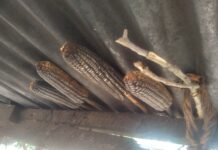By Fred Deya
When Purity Wanjiku Wang’ombe harvested maize produce from her six acre farm in 2012, she was the happiest farmer in the whole of Mirera village in Naivasha District,Nakuru County, but now she is in agony because her large farm has been reduced to a small kitchen garden because of Maize lethal Necrosis (MLN) virus.
Wanjiku’s last bumper harvest was back in 2012 when her six acre farm produced a lot of sacks of maize before the lethal disease sneaked, tampering with maize production that was for a long time lucrative.
“The first time I started noticing funny lice on my maize plantation was in 2013. I later realized that something abnormal has caught up with my crops. In my farm, I managed to harvest only 5 sacks of maize from large farm which is not enough to feed myself and my children as it was before .”Narrates Wanjiku.
When she was asked how the disease has thwarted her system of crowing maize crop, Wanjuku could not hesitate to figure out how the disease has slapped her on the face.

First the elderly farmer can no longer get bumper harvest even though the large chunk of land is still available. She said that her last attempt to grow maize in a large scale was when she used four bags of maize seeds, supplemented with indigenous seeds but she still had a poor return.
According to Wanjuku, out of the maize she planted her expectation was to reap heavily. However, she managed to garner only five sacks of maize, a real set back.
Currently wanjiku’s farming has been reduced to a tiny kitchen garden. She still hopes that there will be a solution to curb the maize disease menace in the area and things will come to normal.
“I still plant maize to see if there can be any improvement. I acquired seeds from Meru which I planted in this garden to give a trial but I cannot see if it will do any better”, says Wanjiku as she points at her depressed maize plantation.
It is clear that Wanjiku is in for another shock because the plants have no sign to do well because they are attacked by the Lethal Maize disease.
Because the work she has done for decades has been thwarted, Wanjiku hoped for an alternative to survive harsh lifestlyle. She has diverted to plant Boma rods (grass) which is cattle feed in the area. She sells the grass to local dairy farmers for a penny for life sustainability.
Mirera farmer hopes to start dairy farming in the near future. At the moment she still has no cattle because she is old and alone but cattle maintenance is costly and needs man power.
Even though crowing of maize in Mirera has been greatly declined, Wanjiku still hopes that their pride will be restored.
Through the research on disease resistance and drought tolerant maize varieties is enduring in the country, a solution is soon surfacing.
Kenya Agricultural and Livestock Research organization (KALRO) in partnership with the International Maize and Wheat Improvement (CIMMYT) is working tirelessly to restore conceit of most of Kenyan farmers.

There are various research facilities in the country correlated to coming up with more tolerant maize seed varieties that are spectacle to do well on any form of whether condition and soil across the country. These facilities include Maize Lethal Necrosis (MLN) screening facility in Naivasha, Kiboko’s Crops Research Station among others.
“There has been a tremendous progress in research of an alternative maize crop disease control since the establishment of MLN screening facility back in September 2011 when we collaborated with KALRO to put up the research facility in Naivasha. The facility in place is one of its kinds because it has not been presented anywhere in the world. The screening machine has the capacity to provide excellent information on maize germ plasm that is resistant to the deadly disease (MLN) ”, Said Dr. Prasanna Bundupalli, CIMMYT Global Maize Program Director.
Speaking to a group of journalists at the facility in Naivasha, Prasanna said that there is tremendous progress in researching on MLN virus.
Up to September 2013 new disease resistant maize varieties have been produced. 90 per cent of materials with broad area of germ plasm have been realized, even though only 5 percent of the findings were confirmed offering resistance.

CIMMYT scientist packed hope for farmers, mostly small holder farmers who are majorly affected by the disease. He said that the control of the disease will restore and improve the livelihood of maize farmers, mostly in East and Southern Africa.
According to the researcher 5 MLN tolerant hybrids have been released in East Africa; two in Uganda, two in Kenya and one in Tanzania. Hybrid MLN resistant variety Buzuka UH534 has been released to farmers for a trial.
Prasanna said that 22 MLN high level resistances to diseases hybrids ire in place for research. He said that by the year 2020 CIMMYT will have 20 MLN tolerant/resistant varieties in East Africa.
Prasanna warned farmers to be cautious about the disease even though the control is being tackled. He encouraged the rotational farming and planting of the same time in a particular planting cycle to control chances of the disease spread.
Over 40 percent of people around the globe depend on maize as staple food, therefore there is much need grow maize crop in whatever climate condition it may be, according Dr. Martin Kropff, Director General ,CIMMYT.
Cropff said that the move to research on way of controlling maize diseases is so tremendous. He said that most of diseases especially maize viruses come due to climate changes. However, the menace can majorly be controlled through resistance/ tolerant maize breeding.














